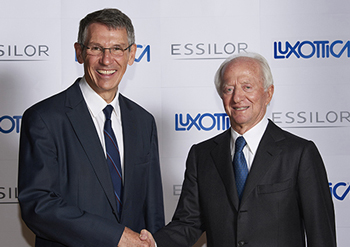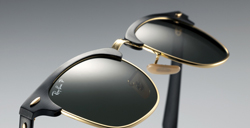 Hubert Sagnieres, chairman and CEO of Essilor (l) with Leonardo
Hubert Sagnieres, chairman and CEO of Essilor (l) with Leonardo
Del Vecchio, chairman of Delfin and executive chairman of
Luxottica Group.NEW YORK—Almost immediately after Essilor and Luxottica announced their merger plan on Jan. 16, questions and theories began to swirl about how the long rumored mega-deal, valued at nearly €50 billion, would impact the optical industry in North America and internationally.
The history-making merger has the potential to reshape the international optical industry by creating “an integrated player dedicated to visual health and superior consumer experience through a combination of Essilor and Luxottica Group,” according to a joint statement from the companies. The combination of the two entities would operate in virtually every sector of the optical industry, from retail and wholesale to frames, spectacle lenses and managed vision care.
The companies—which together would have annual sales exceeding €15 billion and 140,000-plus employees—also identified several areas in which the new entity would have a positive impact on the optical business. These areas include “answering a growing need in visual health and the “appetite for premium branded products,” and creating a company that is positioned to “propose a comprehensive offering combining a strong brand portfolio, global distribution capabilities and complementary expertise in ophthalmic lenses, prescription frames and sunglasses,” Essilor and Luxottica said in their statement.
Yet, the prospect of the two companies combining operations led many to wonder what the impact would be to the rest of the industry and the eyewear consumer. Among the key issues that industry participants told VMail they are grappling with:
- Does the proposed combination of Essilor and Luxottica create a business that is so vast that it can exert control over many aspects of the supply and distribution channels?
- If a goal of the new company is to “grow the industry,” will this growth be more heavily tilted toward the Essilor and Luxottica stable of brands and business services? What aspect of the deal will drive growth for independent labs and ECPs?
- What will the proposed combination of Essilor and Luxottica mean, especially for independent ECPs, with respect to reimbursement schedules and the overall control of product, brand access and service offerings?
- Will independent retailers and labs gain a tactical advantage in the area of superior and unique customer service because they can be more nimble, as some executives suggest?
- Will the proposed merger expand or contract the range of eyewear choices for the end consumer?
- What impact might the Essilor-Luxottica combination have on the e-commerce space, for example, the possible development of an “Amazon-like” e-retail competitor with a comprehensive and price-driven consumer eyewear offering?
While many in the industry are still processing the news and speculating about what the Essilor-Luxottica combination could mean to them, their customers and consumers, comments began to fly immediately on optical social media sites, with reactions ranging from optimism to dismay and uncertainty. Over the past week, many voices have joined the conversation.
VMail reached out to an assortment of industry participants, including suppliers, retailers, wholesalers, managed care executives and independent eyecare professionals, to get their take on the deal and try to envision what the future might look like with a new superpower on the scene. A number of people were not yet ready to be quoted for the record, and some declined to comment.
Some industry veterans told VMail they were not surprised by the move, and had a pragmatic view of its potential impact. “I think the deal makes sense,” said Houston Eye Associates optical director David P. Brown. “Certainly, it’s a dynamic time in our industry, and we see some form of movement everyday…. [These companies] complement each other with virtually no overlap in services.”
Antoine Amiel, president and director of New Look Vision Group, a leading Canadian retail chain that operates 223 fully-owned stores in Canada, was upbeat.
“It’s very good for the industry, because Essilor is a very reliable market player in the sense that they are great believers in product quality and innovation,” Amiel told VMail. “They are mindful of the industry’s profitability, and raising public awareness of eye health. For me, that’s very important, because we optical retailers are at the crossroads of retail and health care, and it’s our mission to raise awareness of eye health. On the business side, raising awareness of eye health will increase traffic.
“I also expect Essilor will now participate in the retail consolidation, now that the taboo has been broken. Until Monday, they were not buying retailers, and now they will become one of the largest retailers. When there is a new player in the consolidation game, it tends to push up valuation of other retailers. We are one of the best retailers in Canada, so that’s good for us.
“Whenever there is an acquisition I’m always very pleased when the client is a very serious, reliable market operator, one that’s rational and cares for the people,” said Amiel. “For a company the size of Luxottica, it’s a lot more comforting that they are being taken over by a responsible operator like Essilor rather than a private investment firm.”
Alan Ulsifer, OD, CEO and president of FYidoctors, another top Canadian retail chain that operates 195 corporate-owned stores, sees the deal as a catalyst that will create new opportunities for independent stores. “Right now there are few details about what will happen after this deal closes and that tends to fan fear, doubt and speculation. But clearly this is a major development. It will stimulate conversations about new kinds of partnerships.
“At FYidoctors, we have invested heavily in doctors' offices, in our own lab, in our systems and our infrastructure. Independents can compete, no matter the competitor, but they have to think of both the patient and the consumer. As things continue to change, we have to be ahead of the curve of anticipating what the consumer wants, the choices a tech savvy consumer may make."
Said Ulsifer, “We will continue looking for strategic partnerships. It incentivizes us to increase our pace of growth, to win in the eyes of the consumer, provide great service, technology and the help doctors expect.”
 Sue Downes, CEO of MyEyeDr., a fast-growing vision care/optical retailer in the U.S. market, with approximately 325 locations, told VMail, “We have meaningful partnerships with most of the key players in our industry. While this is a huge combination, of course, we are viewing the situation by asking, how do we align everyone’s strengths? Change can often be good in the sense that it creates more innovation. Can we forge partnerships to bring new ideas, new solutions in product and service that really serve patients best, and in turn also grow business for everyone?”
Sue Downes, CEO of MyEyeDr., a fast-growing vision care/optical retailer in the U.S. market, with approximately 325 locations, told VMail, “We have meaningful partnerships with most of the key players in our industry. While this is a huge combination, of course, we are viewing the situation by asking, how do we align everyone’s strengths? Change can often be good in the sense that it creates more innovation. Can we forge partnerships to bring new ideas, new solutions in product and service that really serve patients best, and in turn also grow business for everyone?”
Michael Kling, OD, owner and CEO of Invision Optometry, a private optometric practice in San Diego, sees the deal as part of the continued consolidation in eyecare, which he believes is inevitable.
“For payors such as VSP and EyeMed to maintain their market share, it's clear that they believe continued vertical integration will be required to keep their competitive edge,” said Kling. “For Luxottica, the only piece they were missing was the ophthalmic lens business. In order to stay competitive with VSP, it was obviously important to them that they integrate a lens manufacturer into their portfolio.
“As a private practice OD, my concerns always come back to two things: 1) reimbursement and 2) control. As the large payors control an ever increasing number of our patient lives, a larger percentage of our revenue will be dependent on their reimbursement schedules. This further leads to potentially less control over the products and services we offer,” Kling noted.
“An appropriate analogy might be to suppose that there were only two large medical insurance companies—such as Aetna and UnitedHealthcare—and two large pharmaceutical companies such as Pfizer and Novartis,” Kling continued. “Suppose that these two insurance carriers purchased the pharma companies. The concern for the physician is not only potentially reduced reimbursements, but also that they might start dictating which medications should be prescribed for hypertension, for example.”
VMail reached out to VSP Global CEO Jim McGrann to comment about the pending combination. He stated, “As the largest and only not-for-profit vision benefits provider in the United States, VSP remains focused on increasing access to eyecare and connecting our 82 million members around the world with independent optometrists for their eyecare needs.”
Other independent opticians whom VMail spoke with see the Essilor-Luxottica tie-up as an opportunity to further differentiate their practices and business from those of corporate competitors.
“Being an independent just got better,” remarked Alex Thayer, LDA, COT, who owns Look Optical in Maynard, Mass. “That’s because mergers like this make the corporate experience a bigger box experience with less caring, less customization and less choice for consumers.
“People who are passionate about giving great products and services will still be able to differentiate themselves. So I’m excited about my business. It will make my independent shop look like an oasis.”
Ruth Domber, eyewear fashion expert of 10/10 Optics New York City, believes the deal could have a positive effect on a luxury boutiques like hers. “I am aware of the merger and as an owner of an independent luxury eyewear boutique, this is not bad news for me, in fact it could be good. When Luxottica started to buy up boutique brands, like Oliver Peoples, it created a forest fire of sorts and made room for the growth of the boutique industry, which has flourished. It created a market and made room for creative artisan eyewear to prosper."
She said, “My business prospers because patients are looking for beautiful eyewear, which is the antithesis of mass produced collections. The merger doesn’t worry me and I am looking forward to more artisan brands flourishing. People looking for upscale product that is driven by independents drives more product my way.
“People like me won’t touch that mass-produced product, and this fosters growth for the luxury eyewear market,” Domber asserted. “The demand and opportunity for independent luxury, artisan eyewear designers is growing. I haven’t seen this amount of growth in 25 years. Of course, other factors are at play for independents who need to stay on top of their game through marketing and education.”
Tom Hicks, owner of a one-man shop, Oxford Opticians in Oxford, Ohio, also expressed concern about possible changes in the EyeMed insurance which he accepts. “I’m also worried about pricing and my costs which continue to go up. Essilor’s acquisitions of certain labs has raised my costs of doing business with those labs,” said Hicks.
He added, “I also worry about the wholesale costs of product. Look at the wholesale costs of Transitions, which have gone up since they were purchased by Essilor. Basically, I don’t carry a lot of Luxottica products, or name brands. I want to be unique and carry product other people don’t have. That’s what sets me apart from the competition.”
Laura Van Brunt, ABOC, RDO and Jessica Van Brunt, ABOC, both owner/opticians of Van Brunt Optical Haus in Costa Mesa, Calif. took a somewhat dimmer view of the deal.
“It's a shame that customers have the illusion of choice when it comes to all of the brands that Luxottica manufactures, and all the retail outlets that it owns. It's a shame that now, there is also less choice for their lenses as well,” they said. “We choose to support independent eyewear not under the Luxottica umbrella. We also give our customers the choice of lens manufactures. In the past few months, the lab we currently use and a lab we were considering, have both been acquired by Essilor. And now Essilor is merging with Luxottica.
“We wanted to give our customers the choice of something different, and it has just become more difficult to do that as Luxottica absorbs more and more of the companies we do business with,” said the Van Brunts. “I don't see how that would be good for us, or our customers who go out of their way to find the most unique eyewear and lenses. But we will continue to go out of our way to ensure that there is still somewhere for people to find amazing independent eyewear, and lenses that suit their unique personalities and needs.”
 Among suppliers, Hoya Vision Care, a main competitor of Essilor, sees the merger as an opportunity to drive home the message that it is the true friend of the independent eyecare professional.
Among suppliers, Hoya Vision Care, a main competitor of Essilor, sees the merger as an opportunity to drive home the message that it is the true friend of the independent eyecare professional.
“The recent announcement regarding the intended merger of Essilor and Luxottica gives us the opportunity to reaffirm our commitment as the ‘Ally of the Independent Eye Care Professional (ECP),’" said Derek Dodge COO, Hoya Vision Care, Americas. “At Hoya, we continue to support independent eyecare professionals by providing them with science, technology and innovative solutions to provide a better quality of life for their patients.
“Hoya is a customer-centric organization that values the unique bond between practitioner and patient,” said Dodge. “To show our support we continue to make extensive investments in domestic manufacturing, educational resources and customer care that will allow the ECP to better serve the patient and differentiate their practice.
He continued, “Hoya believes in developing long-term relationships with ECPs that provide more choices, protect the value of their brand and to decide what is right for the patient.
Mike Tamerius, chief executive officer of Precision Optical Group, a wholesale lab company based in Creston, Iowa, said he believes mergers such as the Essilor-Luxottica deal open the door to new opportunities for suppliers who can both position themselves as a strong alternative to the mega companies and who are nimble enough to react quickly to industry changes.
“This is not necessarily bad news,” he said of the planned Essilor-Luxottica merger. “The larger these companies get, the more pronounced the difference in customer service becomes. The larger companies just can’t compete with independents on customer service.”
He added, “We’re at a real advantage when things change quickly, also. The larger companies become, the less nimble they are. The more dramatic thing is the emergence of online sales of eyewear,” he said. “To me, that’s a more alarming trend.”
Barry Santini, co-owner of Long Island Opticians in Seaford, N.Y. and a contributing editor to 20/20 Magazine, said he sees “the battlefield” shaping up this way.
“For many ECPs, their reaction is a gut-level, visceral emotional one. One that can be summed up easily as, ‘It's the last straw.’ With few exceptions, most ECPs are increasingly feeling that big optical's agenda has been straying from Main Street optical's agenda. Looking back, for more than 60 years, ECPs have seen ‘their’ patients morph into their (big optical’s) ‘customers.’
“At the same time, branded products have taken on more importance, and many companies that own the brands see the public, in an online age, as their end customer, not the ECP.
“So the battle lines are clear: Is it our patient or their customer?"